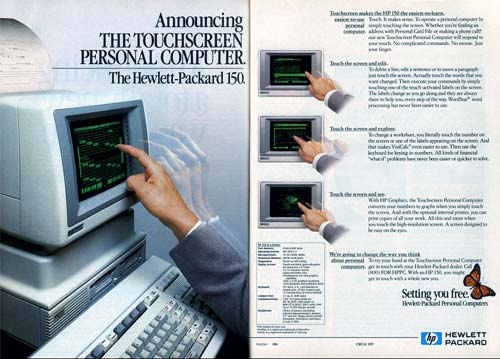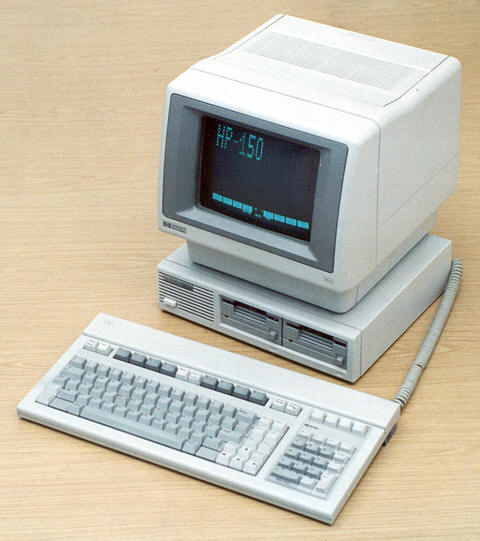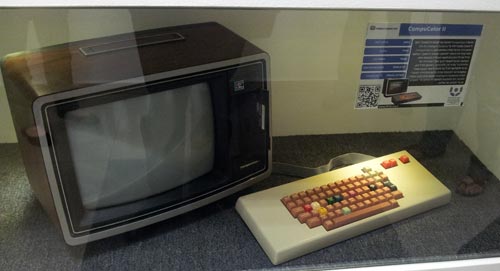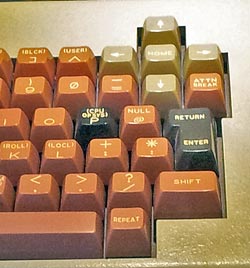Not all cool ideas are actually good.
Back in 1983, around the time the IBM PC made its debut, my boss at Intel had acquired a very innovative personal computer: the Hewlett Packard 150.
I remember it well; it was a really cool machine – at least in the context of its day: it had an 8MHz (yes, 0.008 GHz) CPU and 256KB (0.000256 GB) memory, as well as two floppy disks of 270KB each. It also had that solid look and feel that the better companies gave their machines when they could charge thousands of dollars for them. But what made it super cool was the screen, and the ad here shows you how proud HP was of developing it:

The HP 150 had the first Touch Screen I’ve ever seen on a commercial computer. It was actually a regular nine inch green CRT, with a bezel that had holes all around it with IR emitters and detectors in them; sticking a finger at the screen would block some IR rays and tell the computer where you were pointing. And this is where the designers had failed: they forgot that the human arm is not designed to be held in the air, poking at a surface in front of one’s face. The resultant muscle fatigue was known as Gorilla Arm…
That alone was enough to relegate this screen to the junk heap of failed ideas, and touch screens would have to wait for tablets and devices that can lie flat on a tabletop or be held in one’s hand.
Still, you have to admit it was a good looking machine!

Photo source: Computer museum, Stuttgart University.
While taking in the wonderful Israel Perosnal Computer Museum in Haifa I came face to face with the Intelligent Systems Compucolor II, a bizarre 1977 home computer built into a repurposed 13″ TV set.

What drew my attention was the strange keboard layout: the arrow keys were clustered at the top right corner. This is in contrast to what you will see on every keyboard in the present century, where these keys are invariably at the bottom right of the keyboard.
 So, here we see a layout that has disappeared without any living descendants: an extinct primordial denizen of the keyboard universe. And for good reason: the standard location puts the arrows nearest the user, where the CompuColor II had them farthest away. It’s bad enough that the mechanical issues of old typewriters forced on us the QWERTY layout, with the most used keys out on the top letter row; since those typewriters did not have arrow keys, there is no reason to apply the same counter-ergonomic approach to them too!
So, here we see a layout that has disappeared without any living descendants: an extinct primordial denizen of the keyboard universe. And for good reason: the standard location puts the arrows nearest the user, where the CompuColor II had them farthest away. It’s bad enough that the mechanical issues of old typewriters forced on us the QWERTY layout, with the most used keys out on the top letter row; since those typewriters did not have arrow keys, there is no reason to apply the same counter-ergonomic approach to them too!
It is interesting to note that unlike today’s notebooks, where space is at a premium, the keyboard in these photos has lots of free space around it, and is no doubt made of individual switches; so there was no reason to put the arrows in this awkward position. Someone just hadn’t thought it through. And of course those were early years for home computing, with each manufacturer trying their own ideas, resulting in an Ediacaran Fauna of weird form factors (remember the venerable Commodore 64, whith only two arrow keys that you SHIFTed to move in the remaining directions?). Small wonder, then, that most of these experiments – like this one – left no trace except as museum fossils!
Now, I hate litigation, and like many would rather have companies focus on innovating for the greater good; also, I happen to like Android a lot. Nevertheless, I think many criticizers of Apple in its recent victory over Samsung are missing a key point.
The argument goes, Apple sued Samsung for producing smartphones that are rectangular and with rounded corners – how lame is that?!

Yes, that is lame. But Apple also sued about many other alleged infringements, including the application in a handheld device of multi-touch gesture input – the now ubiquitous “pinch to zoom, flick to scroll” kind of user interface that we all love. And that is a whole different story – one that is hardly lame…
I remember well my first encounter with an iPhone. I remember the feeling of wonder, the ecstasy of experiencing this incredible UI paradigm. It was a revelation, a true revolution, on a par with the first appearance of the mouse-based WIMP interface (which, as an ironic aside, Apple seems to have copied from Xerox for the Lisa and Macintosh computers in the early 80s). It was pure innovation, and with it Apple enabled the very concepts of Mobility and Computing that we all benefit from today.
And that is what Samsung – and Android – had taken from Apple. The overall concept, the basic paradigm, that the iPhone embodies. And yes, I too would have preferred that Apple adopt a more open mind about sharing their technology, but that is not my choice to make. Until they do, let no one say that they’re a bunch of spoiled, un-innovative, litigious whiners suing about the rectangle with round corners. I really think we all do owe them more respect than that!
Photo credit: William Hook under CC license on flickr.



 So, here we see a layout that has disappeared without any living descendants: an extinct primordial denizen of the keyboard universe. And for good reason: the standard location puts the arrows nearest the user, where the CompuColor II had them farthest away. It’s bad enough that the mechanical issues of old typewriters forced on us the QWERTY layout, with the most used keys out on the top letter row; since those typewriters did not have arrow keys, there is no reason to apply the same counter-ergonomic approach to them too!
So, here we see a layout that has disappeared without any living descendants: an extinct primordial denizen of the keyboard universe. And for good reason: the standard location puts the arrows nearest the user, where the CompuColor II had them farthest away. It’s bad enough that the mechanical issues of old typewriters forced on us the QWERTY layout, with the most used keys out on the top letter row; since those typewriters did not have arrow keys, there is no reason to apply the same counter-ergonomic approach to them too!

